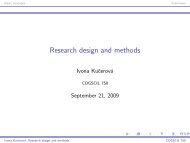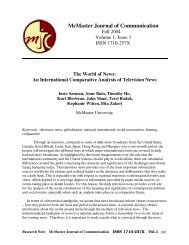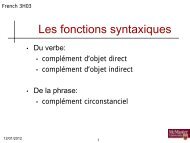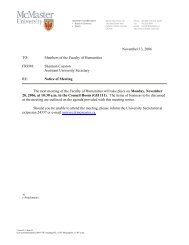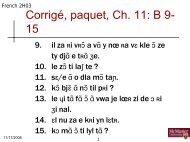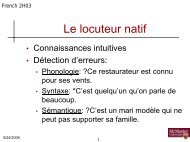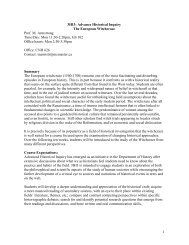The Syntax of Givenness Ivona Kucerová
The Syntax of Givenness Ivona Kucerová
The Syntax of Givenness Ivona Kucerová
You also want an ePaper? Increase the reach of your titles
YUMPU automatically turns print PDFs into web optimized ePapers that Google loves.
functionalist tradition there has been prevailing disagreement on whether the inflected verbal<br />
form can be characterized as given or new (for example, Sgall (1967); Hajičová (1974);<br />
Sgall et al. (1980)) or whether the verb forms a special category which is neither given nor<br />
new (for example, Firbas 1964; Svoboda 1984). I will argue that the finite verb is indeed either<br />
given or new. <strong>The</strong> reason why it is so difficult to characterize its information structure<br />
status is that the verb is <strong>of</strong>ten ambiguous between being given and new. More precisely,<br />
the partition between given and new <strong>of</strong>ten either immediately precedes the finite verb or<br />
immediately follows it.<br />
I will argue that this is a side-product <strong>of</strong> an independent property <strong>of</strong> G-movement. In<br />
particular, I will argue that G-movement is parasitic on head movement. <strong>The</strong> idea that<br />
a certain type <strong>of</strong> movement may be dependent on head movement has been already proposed<br />
in other contexts (see, for example, Holmberg 1986 for Object shift and Heycock<br />
and Kroch 1993; Johnson 2002 for coordination) but it is not well understood. I will provide<br />
a possible motivation <strong>of</strong> this restriction on G-movement in section 2.3. In this section<br />
I will show that we can find two possible motivations for head movement in connection<br />
with G-movement. Either (i) head movement is an independent instance <strong>of</strong> G-movement,<br />
and the verb is given, or (ii) the verb is new and head movement facilitates G-movement<br />
<strong>of</strong> some other element. In both cases head movement is understood as part <strong>of</strong> the narrow<br />
syntax (contrary to Chomsky (2000, 2001, 2004a)).<br />
In the simple cases we have considered so far, the relative word order <strong>of</strong> the new part<br />
was the same as the basic word order. Consider (32).<br />
(32) a. And what about the lollipop?<br />
b. #Lízátko malá holčička našla.←− # O || S V<br />
lollipop.Acc little girl.Nom found<br />
c. Lízátko || našla malá holčička. ←− O || V S<br />
lollipop.Acc found little girl.Nom<br />
‘A little girl found the lollipop.’<br />
Our system as it is set up now predicts that the word order <strong>of</strong> the new elements should not<br />
change, thus, the verb should linearly follow the subject, as in (32-b). This prediction is,<br />
however, incorrect. As we see in (32-c), the verb must precede the subject. I argue that this<br />
is a result <strong>of</strong> a more general restriction on G-movement that has not been discussed yet. A<br />
first approximation <strong>of</strong> the restriction is given in (33). I will discuss the restriction in further<br />
detail in section 2.3.<br />
(33) Head movement restriction on G-movement:<br />
α G can G-move out <strong>of</strong> XP only if X 0 moves out <strong>of</strong> XP as well.<br />
<strong>The</strong> restriction is meant to capture the fact that if α G G-moves, the head in which projection<br />
α G was base generated moves as well. We will see only in section 2.3 how exactly<br />
the head movement restriction is motivated and when it applies. For now, let’s stay with<br />
the following claim: there are two cases in which a head moves because <strong>of</strong> G-movement:<br />
(i) the head itself is given and as such it needs to undergo G-movement; (ii) the head itself<br />
23





